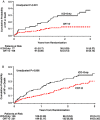Effectiveness of cardiac resynchronization therapy in diabetic patients with ischemic and nonischemic cardiomyopathy
- PMID: 22276624
- PMCID: PMC6932461
- DOI: 10.1111/j.1542-474X.2011.00476.x
Effectiveness of cardiac resynchronization therapy in diabetic patients with ischemic and nonischemic cardiomyopathy
Abstract
Background: Diabetes mellitus (DM) increases the risk for the development of both ischemic and nonischemic cardiomyopathy. We aimed to identify differences in response to cardiac resynchronization therapy with a defibrillator (CRT-D) among DM patients with ischemic or nonischemic cardiomyopathy.
Methods: Cox proportional hazards regression modeling was used to assess clinical response to CRT-D (defined as CRT-D vs. defibrillator-only reduction in the risk of heart failure [HF] or death) and echocardiographic response (defined as percent reduction in left ventricular end diastolic and systolic volume [LVEDV and LVESV, respectively] at 12 month of follow-up compared with baseline values) among 552 diabetic patients with ischemic (n = 367) or nonischemic (n = 185) cardiomyopathy enrolled in MADIT-CRT.
Results: The clinical benefit of CRT-D was more pronounced among nonischemic patients (HR = 0.30 [P < 0.001] than among ischemic patients (HR = 0.59 [P = 0.004]; P for interaction = 0.10). Nonischemic patients also experienced significantly greater reductions in LVESV and LVEDV at 12 months with CRT-D compared with ischemic patients (P < 0.001 for both). Subgroup analysis showed that the most pronounced reduction in HF or death with CRT-D therapy occurred in nonischemic patients who were women (83% risk-reduction [P < 0.001]), had a lower BMI (<30/kg/m(2) : 79% risk-reduction [P < 0.001]), or had left bundle branch block at enrollment (82% risk-reduction [P < 0.001]).
Conclusions: The present study shows that treatment with CRT-D in at-risk cardiac patients with DM is associated with substantial reductions in the risk of HF or death and improvement in cardiac remodeling in those with ischemic and nonischemic cardiomyopathy, with a more pronounced benefit in patients with nonischemic disease.
© 2012, Wiley Periodicals, Inc.
Figures



Similar articles
-
Response to preventive cardiac resynchronization therapy in patients with ischaemic and nonischaemic cardiomyopathy in MADIT-CRT.Eur Heart J. 2011 Jul;32(13):1622-30. doi: 10.1093/eurheartj/ehq407. Epub 2010 Nov 12. Eur Heart J. 2011. PMID: 21075774 Clinical Trial.
-
Cardiac resynchronization therapy reduces the risk of cardiac events in patients with diabetes enrolled in the multicenter automatic defibrillator implantation trial with cardiac resynchronization therapy (MADIT-CRT).Circ Heart Fail. 2011 May;4(3):332-8. doi: 10.1161/CIRCHEARTFAILURE.110.959510. Epub 2011 Feb 24. Circ Heart Fail. 2011. PMID: 21350054 Clinical Trial.
-
The effect of intermittent atrial tachyarrhythmia on heart failure or death in cardiac resynchronization therapy with defibrillator versus implantable cardioverter-defibrillator patients: a MADIT-CRT substudy (Multicenter Automatic Defibrillator Implantation Trial With Cardiac Resynchronization Therapy).J Am Coll Cardiol. 2014 Apr 1;63(12):1190-1197. doi: 10.1016/j.jacc.2013.10.074. Epub 2013 Dec 11. J Am Coll Cardiol. 2014. PMID: 24333490 Clinical Trial.
-
Efficacy of Implantable Cardioverter-Defibrillator Therapy in Patients With Nonischemic Cardiomyopathy: A Systematic Review and Meta-Analysis of Randomized Controlled Trials.JACC Clin Electrophysiol. 2017 Sep;3(9):962-970. doi: 10.1016/j.jacep.2017.02.006. Epub 2017 May 31. JACC Clin Electrophysiol. 2017. PMID: 29759721
-
An updated meta-analysis of cardiac resynchronization therapy with or without defibrillation in patients with nonischemic cardiomyopathy.Front Cardiovasc Med. 2023 Jul 12;10:1078570. doi: 10.3389/fcvm.2023.1078570. eCollection 2023. Front Cardiovasc Med. 2023. PMID: 37502189 Free PMC article. Review.
Cited by
-
Multipolar pacing by cardiac resynchronization therapy with a defibrillators treatment in type 2 diabetes mellitus failing heart patients: impact on responders rate, and clinical outcomes.Cardiovasc Diabetol. 2017 Jun 9;16(1):75. doi: 10.1186/s12933-017-0554-2. Cardiovasc Diabetol. 2017. PMID: 28599667 Free PMC article. Clinical Trial.
-
Roles and indications for use of implantable defibrillator and resynchronization therapy in the prevention of sudden cardiac death in heart failure.Heart Fail Rev. 2016 Jul;21(4):433-46. doi: 10.1007/s10741-016-9542-y. Heart Fail Rev. 2016. PMID: 26910804 Review.
-
The year of 2012 in electrocardiology.Ann Noninvasive Electrocardiol. 2013 Jul;18(4):305-10. doi: 10.1111/anec.12068. Ann Noninvasive Electrocardiol. 2013. PMID: 23879270 Free PMC article. Review. No abstract available.
-
Impact of diabetes on clinical outcome of patients with heart failure undergoing ICD and CRT procedures: results from the German Device Registry.ESC Heart Fail. 2020 Jun;7(3):984-995. doi: 10.1002/ehf2.12613. Epub 2020 Feb 18. ESC Heart Fail. 2020. PMID: 32068978 Free PMC article.
-
Cardiac Resynchronization Therapy Outcomes in Type 2 Diabetic Patients: Role of MicroRNA Changes.J Diabetes Res. 2016;2016:7292564. doi: 10.1155/2016/7292564. Epub 2015 Nov 9. J Diabetes Res. 2016. PMID: 26636106 Free PMC article. Review.
References
-
- Singh S, Dhingra S, Ramdath DD, et al Risk factors preceding Type 2 diabetes and cardiomyopathy. J Cardiovasc Transl Res 2010;3:580–596. - PubMed
-
- Boudina S, Abel ED. Diabetic cardiomyopathy revisited. Circulation 2007;115:3213–3223. - PubMed
-
- Das SR, Drazner MH, Yancy CW, et al Effects of diabetes mellitus and ischemic heart disease on the progression from asymptomatic left ventricular dysfunction to symptomatic heart failure: A retrospective analysis from the Studies of Left Ventricular Dysfunction (SOLVD) Prevention trial. Am Heart J 2004;148(5):883–888. - PubMed
-
- Martin DT, McNitt S, Nesto RW, et al Cardiac resynchronization therapy reduces the risk of cardiac events in patients with diabetes enrolled in the multicenter automatic defibrillator implantation trial with cardiac resynchronization therapy (MADIT‐CRT). Circ Heart Fail 2011;4:332–338. - PubMed
Publication types
MeSH terms
LinkOut - more resources
Full Text Sources
Medical
Research Materials
Miscellaneous

